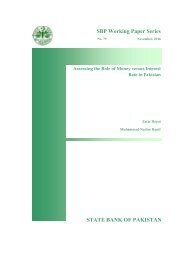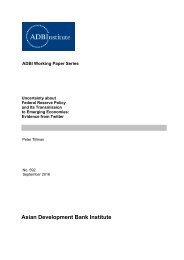SBP Working Paper Series STATE BANK OF PAKISTAN
n?u=RePEc:sbp:wpaper:74&r=mon
n?u=RePEc:sbp:wpaper:74&r=mon
Create successful ePaper yourself
Turn your PDF publications into a flip-book with our unique Google optimized e-Paper software.
their empirical counterparts. All in all, based on moment matching exercise for relevant second order<br />
moments, Cash in Advance constraint model outperforms the other two models.<br />
In addition to looking at relative volatility, contemporaneous correlation with output and autocorrelation<br />
of relevant macroeconomic variables, we also compare the simulated output and inflation with the actual<br />
deviation of these variables from trend in data,<br />
Figure 10 shows the comparison of actual and simulated deviations of quarterly GDP and inflation from<br />
trend. The actual deviations from trend are computed using Hodrick-Prescott Filter whereas simulated<br />
deviations are computed using coefficients of policy functions coming from rational expectations solution<br />
of the three models and innovations in shock variables <br />
a<br />
, <br />
<br />
and <br />
r<br />
.<br />
These innovations were obtained from estimations described in Tables 2, 3 and 4. Considering the facts<br />
that the models are fairly simplified structures and we have taken only two shocks, we see that, to a large<br />
extent, models have been capable of capturing the direction of change in GDP and inflation.<br />
However, all models over-predict the magnitude of change in GDP and inflation. This fact could be<br />
attributed to lack of various nominal and real frictions in our models.<br />
5.2 Impulse Response Functions<br />
After considering the second order moments for all three models and their empirical counterparts from<br />
both annual and quarterly data, we now turn our attention to the impulse response functions (IRFs)<br />
generated in response to various exogenous shocks for all three models<br />
Figure 11 shows that a positive technology shock leads to a rise in output, investment, consumption, and<br />
real interest rate in all three models. One standard deviation shock in TFP causes almost 4% increase in<br />
output and almost 12 percent increase in investment relative to their steady states. On the other hand,<br />
inflation declines in response to a positive technology shock.<br />
The impulse response function of various macroeconomic variables in response to a positive technology<br />
is almost identical for MIU, CIA and Taylor rule model. However, the response of nominal variables<br />
differ between the Taylor rule model and the other two models of money growth. The right panel in the<br />
second row of Figure 11 shows that both inflation and nominal interest rate declines quite significantly in<br />
response to a positive technology shock. The impulse response functions shown in Figure 11 are<br />
consistent with impulse response functions of these models in the literature.<br />
The Figure 12 shows the impulse response functions in response to a monetary policy shock, which in<br />
case of MIU and CIA is a money growth shock and for the Taylor rule model it is an interest rate shock.<br />
Furthermore, the figure also shows that an expansionary monetary policy shock causes an increase in<br />
output, investment, consumption and inflation in the MIU and Taylor rule model. The magnitude and<br />
persistence of impulse responses vary for three models, as output increases by 1% in the MIU model and<br />
by 2% in the Taylor rule model. Also, the output in MIU model returns to its steady state value after<br />
around 5 quarters, while it returns to its steady state value after 3 quarters in the Taylor rule model.<br />
The response of nominal variables in response to an expansionary monetary policy shock is similar for the<br />
two models with money growth rate (MIU & CIA). However, the model with interest rate rule shows<br />
27






